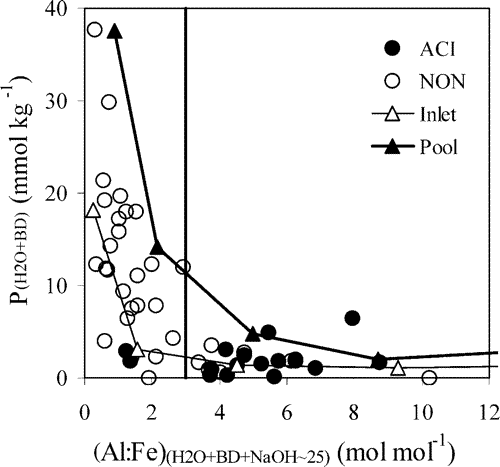 Release of reactive (phosphate-like) phosphorus (P) from freshwater sediments represents a significant internal P source for many lakes. Hypolimnetic P release occurs under reducing conditions that cause reductive dissolution of ferric hydroxide [Fe(OH)3]. This hypolimnetic P release may be naturally low or artificially reduced by sediment with naturally high or artificially elevated concentrations of aluminum hydroxide [Al(OH)3]. We present field and laboratory data for a common extraction analysis of sediments from 43 lakes differing in trophic status, pH regime, climate, and P loading. The results indicate that a simple sequential extraction of sediment may be a useful predictor of sediment’s ability to release P. Sequential extractions of sediment P, Al, and Fe by water (H2O), bicarbonate−dithionite (BD), and NaOH (at 25 °C) showed that negligible amounts of P would be released from lake sediments during hypolimnetic anoxia if either (1) the molar AlNaOH∼25:FeBD ratio is >3 or (2) the molar AlNaOH∼25:P(H2O+BD) ratio is >25. These ratios can be used as operational targets for estimation of sediment P release potential and Al dosing of P-rich sediment to prevent hypolimnetic P release under anoxic conditions.
Release of reactive (phosphate-like) phosphorus (P) from freshwater sediments represents a significant internal P source for many lakes. Hypolimnetic P release occurs under reducing conditions that cause reductive dissolution of ferric hydroxide [Fe(OH)3]. This hypolimnetic P release may be naturally low or artificially reduced by sediment with naturally high or artificially elevated concentrations of aluminum hydroxide [Al(OH)3]. We present field and laboratory data for a common extraction analysis of sediments from 43 lakes differing in trophic status, pH regime, climate, and P loading. The results indicate that a simple sequential extraction of sediment may be a useful predictor of sediment’s ability to release P. Sequential extractions of sediment P, Al, and Fe by water (H2O), bicarbonate−dithionite (BD), and NaOH (at 25 °C) showed that negligible amounts of P would be released from lake sediments during hypolimnetic anoxia if either (1) the molar AlNaOH∼25:FeBD ratio is >3 or (2) the molar AlNaOH∼25:P(H2O+BD) ratio is >25. These ratios can be used as operational targets for estimation of sediment P release potential and Al dosing of P-rich sediment to prevent hypolimnetic P release under anoxic conditions.
Keywords: aluminum hydroxide; bicarbonate-dithionite; ferric hydroxide; hypolimnetic P release; phosphorus; sediments
